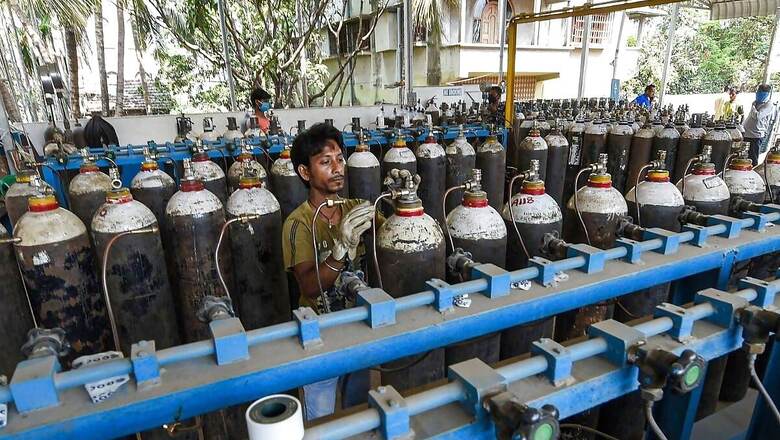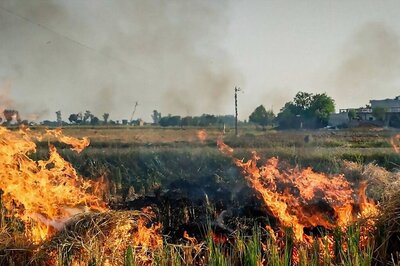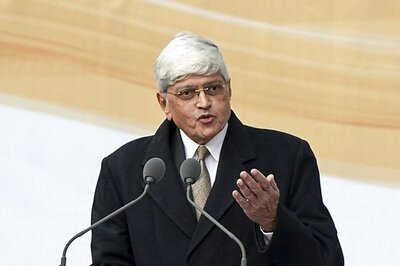
views
In most parts of the country, there is a mad scramble for oxygen. In this second wave of Corona pandemic, more than 3 lakh people are added to the list of infected people every day and it is claiming more than two thousand lives daily. The unavailability of oxygen is a major reason for deaths this time. The question is, was there no preparation keeping in mind the requirements of oxygen or is it the tsunami of the second wave that did not allow enough preparations? The fact lies between these two extremes.
The Home Ministry has banned the industrial use of oxygen. At the Deendayal port of Kandla, a special cylinder iron has been imported by ships to make oxygen cylinders. Oxygen concentrators have been brought from Singapore by flights. Portable oxygen generators are being imported from France. At all the steel plants in the country, be it private or public sector, industrial grade oxygen is being converted into medical grade oxygen on a war footing. Oxygen Express is plying on railway tracks. Today morning, a special train carrying oxygen has left Jamnagar for Maharashtra. Oxygen tankers are allowed through green corridors. The Centre has announced to provide money for the installation of PSA oxygen generation plants in every district of the country. The big private companies are either buying cryogenic liquid oxygen tankers from foreign countries quickly or sending oxygen tankers from their plants in different parts of the country.
Delhi suffers most from oxygen deficiency
Delhi was reeling under the crisis of oxygen shortage for the past week. Its chief minister Arvind Kejriwal has written letters to big industrial houses to help Delhi with oxygen. These are the same industrial houses that he was abusing just a few days back. Prime Minister Narendra Modi under whose leadership the Centre is trying its best to make oxygen available, is doing one meeting after another. He is consulting all the chief ministers of the states and also with those companies that could supply oxygen so that it could be made available immediately. And when one talks about the efforts on a war footing, then this is not just a phrase – from the Globemaster of the Indian Air Force to all the big goods carrier planes have been pressed into service to carry oxygen to the needy states.
Why oxygen crisis escalated
Now the question is, when all these efforts are being made, why a hullaballoo is created in the name of oxygen? Why are people not able to find oxygen cylinders and why is it not available to the hospitals and why even doctors have to raise the issue of the shortage of critical oxygen before cameras? News is pouring in of patients dying due to unavailability of oxygen in hospitals in different parts of the country. From Lucknow to Patna to Jaipur, and from Pune to Bhopal and Mumbai, everywhere it’s the same story.
Was there no preparation?
So, should one consider that there was no preparation to supply oxygen or it was not enough? To understand this, first, we will have to understand what is actually medical grade oxygen and what is its economy, and the arrangements for its supply.
There was no dearth of oxygen in the first wave
In the time just before the pandemic struck last year during the first wave, in February, on an average 1,000-1,200MT medical grade oxygen was required. In hospitals, neither ventilators nor oxygen was so much in demand. In any big hospital, the refilling once in a month by a big tanker was enough. But by April 2020, the corona cases started spiking. Still, the demand for oxygen did not cross 1,500MT levels. By September, the cases of corona started coming down and the demand for oxygen again fell to old levels, which was around 1,000MT. This was the time when work on the development of vaccines started in the country. PM Modi himself had visited these facilities to see their progress. Lastly, from January 16, Corona Warriors started getting jabs.
No one cared at the beginning of the year
Most of the people and political parties were unaware of the second wave of the coronavirus. This is evident by the fact that in many states local elections were held. Leaders addressed big election rallies without wearing masks and most of them had their masks dangling from their neck instead of covering their nose and mouth. Hundreds of marriages and political rallies were held with heavy attendance. Corona guidelines were thrown out of the windows. People travelled to UP and Bihar by plane from Maharashtra to celebrate Holi and carried the virus with them when they got back to Mumbai, and thus, Mumbai fell into the grip of a corona spike again. This led to the heavy spike in corona infection in cities as well as villages.
Heavy lapses in Delhi
National capital Delhi was almost calm. The crowds on the roads were enough to tell people that the capital had forgotten the pain of the last wave of corona infections. In the rest of the country also the scene was not different. People had started forgetting to wear masks. Whenever four people gathered, the first thing they did was to take off the masks and enjoy their time. This led to the tsunami of corona between March 15 to April 15 and now lakhs of people are getting infected daily.
Oxygen demand spiked six times
The new strain of the virus was infecting not five people from one carrier but it was reaching 30 in just 72 hours, and that is why it took merely a few weeks to reach the number of three lakh infections. And with this, India which has tackled the virus very prudently in the first wave, found itself helpless when the second wave struck. Hospitalisation and deaths soared and this also pushed up the demand for oxygen. The oxygen demand which had not surpassed 1,500MT during the first wave now increased to the level of 6,000MT, and this led to a panic situation as this large volume of oxygen was not coming from anywhere.
Centre had started preparations last year itself
Is it that the central government led by Prime Minister Narendra Modi had not thought about it or was it underprepared? If it is a matter of oxygen, then the Modi government had seen what had happened in the US and Europe when they were struck by a second wave and had sanctioned around Rs 200 crore for installation of 162 pressure swing adsorption (PSA) medical oxygen generation plants in the different parts of the country. The tender for this was issued in October 2020. The Health and Family Welfare Ministry had to get these plants installed and the concerned state governments had to make the land available and prepare the site for this. This could have ensured the oxygen supply and the dependency on tankers could have been reduced.
Now every district will have a PSA oxygen plant
This Sunday, the Modi government took the decision of installing PSA plants in 551 districts of the country and the budget for this will be met by the PM CARES Fund. The formalities of installing these plants should have been completed by December 2020 but this could not happen because the health ministry was not given site preparation certificates by the states where these plants were to be installed. Not even 50 percent of the approved capacity was ready and the state governments did not take the plan seriously; not even the Delhi government where there is a mad scramble for oxygen. For the national capital, 8 such plants were approved, but Delhi could install just one such plant and that too in a hospital in Burari on March 17 when corona had started knocking at the doors with vengeance. The remaining seven plants could not become operational. The Health Ministry says that the Delhi government did not make the sites available in time. These plants were to be installed in those hospitals where the maximum number of Covid patients are hospitalised, be that Deendayal Hospital or Lok Nayak Jai Prakash Narayan Hospital. Had all the 8 plants been running to full capacity, around 14.50MT oxygen could have been available to Delhi and the situation would not have deteriorated to that extent.
Approval for medical grade oxygen was given in April 2020
Now the question is, was the Modi government complacent after giving approval to PSA plants? No, this was not the case. Had this been the case, the production of 6,000MT medical grade oxygen according to demand was not possible. The Modi government had done the preparation for this in April 2020 itself when the first wave of Covid had struck in the country and nobody knew that there will be so much demand for oxygen just after one year later, India will be gasping for breath, and this would make headlines the world over.
Country can produce around 8,500MT oxygen
In April 2020, the Modi government had taken a farsighted decision that all industrial units including the public sector where industrial grade oxygen is produced, should be provided permission to produce medical grade oxygen if need arises. Accordingly, all the big plants were given this permission and they installed the required equipment at their facilities and all the protocol covering this issue was formalised. This was the reason that for the past fortnight when the demand for oxygen spiked six times, production challenges were not faced. India has the capacity of producing 8,500MT oxygen and it has a stock of around 4,000MT.
Supply chain management is the real problem
Now, this is natural to ask why so much panic is seen all around for the unavailability of oxygen when enough capacity for production exists? This is because of supply chain management. Actually, nobody had imagined that a situation like this will arise where so much oxygen will be needed to ferry across the country by tankers and that too so quickly. And the demand across the country was so uneven. It has been seen that Mumbai, Pune, Delhi, Lucknow, and Patna were the places where oxygen demand was very high while most of the oxygen generation capacity existed in the eastern part of the country – in Vizag, Jamshedpur, Bokaro, Burnpur and Durgapur steel plants to Rourkela and Bhilai.
Oxygen transportation is not easy
The nature of oxygen produces the biggest challenge in its transportation. This is essential for life and it is also highly inflammable. The vacant tankers of oxygen can be transported from one place to another by the Air Force planes in merely a few hours but full tankers cannot be transported like this. The trains carrying liquid medical oxygen (LMO) cannot run with speeds of more than 60-65 km per hour and tankers on the road carrying this liquid cannot be racing at speeds above 50km per hour.
Cryogenic tankers have been purchased to carry oxygen
Due to the inflammable nature, it is not possible to transport liquid oxygen in a plane. This is the reason that despite its availability at the plant, its transportation becomes a challenge and it took many days before it reached the hospitals where it was required. No arrangement was enough to meet this sudden rise in demand. There were not enough tankers available to carry the oxygen nor filling stations were nearby. That is why the private companies had to chip in to help. The cryogenic tankers were purchased for this purpose. This liquid oxygen turns solid at a temperature of -219 degrees Celsius and it turns into vapour at -182 degrees Celsius. So a cryogenic tanker is required to transport liquid oxygen which is made from a special metal.
Delhi was not prepared
When the oxygen crisis started, there was a mad scramble among states to get it; especially in Delhi and its neighbouring states. Delhi’s Arvind Kejriwal government did not try to install its own oxygen plant. Efforts were not made to install PSA plants with the help of funds made available by the PM CARES Fund. That was the reason why the situation spun out of control in Delhi as it has just one PSA plant ready with it. On one hand, Delhi was talking so much about world-class mohalla clinics, and on the other hand it could not manage even oxygen for its hospitals when the need arose and it was begging for it. It even asked for help from those companies which it had denounced to shine its own politics.
The problem of NCR is complex
There was another reason why the problem in Delhi spiralled out of hand. It is the capital of the country and it has a huge army of opinion makers. Mumbai and Maharashtra are still throwing up the largest number of Covid cases, but the maximum noise is made for Delhi. Being the national capital is also a problem for Delhi. The city has a huge population and then it has a huge number of people coming to work from places like Noida, Greater Noida, Ghaziabad, Gurugram, Faridabad and Sonipat. These cities are in other states but they affect Delhi in every way. There are people who stay in Delhi and work in these places and also vice versa. It is difficult to have a combined work plan for these floating masses. More than that, there are four hospitals in Delhi that are controlled by the Centre – AIIMS, Safdarjung, RML and Lady Hardinge. All other hospitals come under the Delhi government. This leaves much scope for confusion and mismanagement. And whatever remained, was ruined by CM Kejriwal as when he was participating in a meeting with PM Modi, he tried to wash his hands off of all the responsibilities and blamed the Centre for all the problems.
Whose responsibility to keep people healthy?
Most of the state governments ruled by non-BJP parties have blamed the Modi government for the oxygen mess. It’s not just the oxygen, it is also about the ventilator and vaccines. Though most of the state governments who blame the Centre for interfering in the affairs of the state forget that health is a state subject under the Constitution. The Finance Commission had suggested adding the subject of Health to the Concurrent list when states were found lacking on meeting the requirements to fight the corona war. But state governments did not agree to it.
After situation became grim, PM Modi took command
There have been attempts to blame PM Modi for the oxygen mess. Now the question is, what has Modi done for this. He had warned the states but they did not pay any attention and were not prepared. The Health Ministry wrote many letters to the states about the second wave of corona. But most of the states did not prepare themselves for the fight, thinking this problem is now behind them. When in the first week of April, the situation got out of hand, the PM had to jump in. He had two meetings with the chief ministers of the states and he also had meetings with the governors.
Oxygen supply to get better in a week’s time
From allocating oxygen provision to resolving oxygen transportation issues among states had to be done by the Prime Minister, apart from using airplanes and starting trains only for transporting oxygen. Going by the sources from high offices, these efforts will help in providing oxygen to most of the states within a week and in the meantime, the peak of the second wave of corona, which has come like a tsunami, will also start coming down after reaching its zenith.
The tsunami of corona is a lesson for everyone
There are many lessons from this tsunami. The state governments would have to think about strengthening their oxygen supply. They will have to establish oxygen PSA plants in every district and the local hospitals will need to strengthen their own personal oxygen supply in lieu of the demand. The business of medical oxygen is with the private sector. Companies such as INOX and LINDE have become well-known within days and everyone has their names on the tip of their tongues. This is primarily because these two companies through their oxygen tankers have become synonymous with saving lives, and getting the oxygen within these tankers is the only way life gets saved. If the tanker doesn’t reach on time then that creates furore and a patient’s life is in danger. This kind of a situation is obviously not good and it is important that, on a priority basis, PSA plants are set up in every district with the help of the PM CARES Fund, so that oxygen supply can be made available at local levels even in normal times and tankers that bring oxygen from faraway places can be kept for emergencies. The unavailability of oxygen at the local level created pandemonium.
No chaos at places where arrangements were in place
This chaos did not penetrate areas where arrangements to tackle this new wave of corona were already in place. For example, in Jammu and Kashmir, which is under the central government’s rule, lieutenant governor Manoj Sinha had started working on installing a captive oxygen plant three months ago. In the beginning, the bureaucracy was opposing this, thinking that it would not be required there. But Sinha knew that if under any circumstances this mountainous region requires oxygen, then it would be very difficult to supply it. It would take days for oxygen cylinders to reach from the plains and in the meantime, this could even lead to deaths. Sinha’s preparations are today proving useful for Jammu and Kashmir.
The situation is the same for Gujarat’s biggest city Ahmedabad. Ahmedabad’s municipal corporation had estimated the problem that will arise with regard to oxygen supply in the city which has a population of more than 60 lakhs. Within a short period of time, the officials of the municipal corporation brought oxygen cylinders from Kutch and Kalol and therefore strengthened their storage capacity. In fact, they brought oxygen cylinders that were attached to old ships from the Alang shipbreaking yard. They even made industrial units provide their oxygen cylinders for medical use. For these reasons, Ahmedabad did not witness the clamour for oxygen that Delhi is witnessing.
Better coordination and monitoring needed
To stop such scrambling, it is essential that states and the Centre work in tandem. That central health schemes are implemented in the states will have to be ensured by the Centre by putting pressure on them and these programmes need to be monitored. States will have to shed their complacency. They will have to think about supplying oxygen to those big hospitals that are charging lakhs of rupees from the patients in the name of corona treatment. But instead of arranging oxygen, they are blaming the Centre. If all these related wings do not perform their duties, then the system will again break down when another pandemic hits the country and there will be pain and wailing all around. Thousands of people may lose their lives merely because the states could not provide the lifesaving oxygen which is as cheap as Rs 17-18 per kilolitre but is now sold for Rs 35-36 per kilolitre.
Common people will also have to play a role
Those people who are scrambling for oxygen too will have to be responsible in their behaviour and will have to tread carefully. Otherwise, it will be extremely difficult to make oxygen available to those who need it most. A critical corona patient needs 10 litres of oxygen per hour when he is on oxygen support and this increases to 60 litres when the patient is on a ventilator, and for 24 hours the requirement spirals to thousands of litres. So in a tsunami-like situation, no arrangement will be sufficient. Even those courts and green tribunals that give orders for immediate redressal of the problem should think of those times when such plants are not allowed in the name of environmental protection; and even if they are established, they are not allowed to run smoothly. Vedanta’s plant in Tamil Nadu is an example. This plant can produce 1,000MT oxygen, but courts for a long time did not let that happen. Finally, the Supreme Court allowed it on Tuesday. Now we have to learn from this situation; otherwise, we will have to pay a greater price in the future in the same situation, if it arises again.
Read all the Latest News, Breaking News and Coronavirus News here. Follow us on Facebook, Twitter and Telegram.




















Comments
0 comment